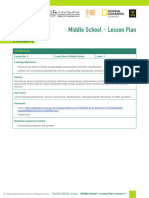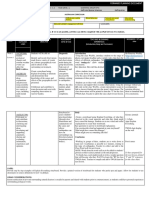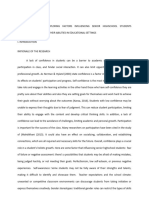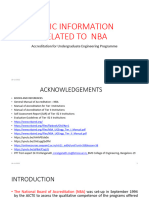Lesson Plan - Evacuations
Lesson Plan - Evacuations
Uploaded by
api-359191228Copyright:
Available Formats
Lesson Plan - Evacuations
Lesson Plan - Evacuations
Uploaded by
api-359191228Original Title
Copyright
Available Formats
Share this document
Did you find this document useful?
Is this content inappropriate?
Copyright:
Available Formats
Lesson Plan - Evacuations
Lesson Plan - Evacuations
Uploaded by
api-359191228Copyright:
Available Formats
Lesson Plan
Class: Stage 3 Year 5 Date:15/5/2017 Time: Start: 12:00
Finish: 12:40
Key Learning Area: Geography Lesson Topic: Bushfires- Evacuation plans
Recent Prior Experience (specific relevant concepts, skills and values the school students have experienced prior to this lesson):
This is the fifth lesson in a unit of work on bushfires. Previously, Ss have learnt about preparing and preventative measures of bushfires and have begun
learning about responding to bushfires. Ss have used inquiry based learning within their learning experiences to deepen their understanding.
Syllabus Outcome(s): Indicators of Learning for this lesson: Assessment:
GE3-3- Compares and contrasts
By the end of this lesson, students will: - Strategic questioning (informal, formative)
influences on the management of places
and environments
- Identify how to effectively prepare and respond to bushfires - Purposeful roving (informal, formative)
EN3-1A-Participate in and contribute to (GE3-3)
discussions, clarifying and interrogating - Group reflection (informal, formative)
ideas, developing and supporting - Create and present an effective evacuation (GE3-3, EN3-1A,
arguments, sharing and evaluating MA3-9MG)
information, experiences and opinions.
MA3-9MG-Selects and uses the SMART goal: By the end of this lesson, students will be able to
appropriate unit and device to measure create an evacuation plan that can be presented to the class with
lengths and distances, calculates at least two features that would be effective in a school.
perimeters, and converts between units of
length.
Any safety issues to be considered: Resources:
Font size on the SMART board PowerPoint slides
Adequate space for floor use Beach ball- permanent marker
Reflective flame- red, orange and yellow paper, double sided tape, butchers paper
Certificate/handout
Alarm
Class roll
High visibility vest
Evacuation point sign
Fire hats
Fire hazard warning sign
Australian Catholic University 1 2013
LESSON SEQUENCE
Lesson Content / Indicators of Timing Teaching Strategies / Learning Experiences: Resources and Organisation:
Learning (What is Taught): (mins) (How it is taught)
I INTRODUCTION
Evacuation meeting point sign
Introduce the lesson:
Indicator: Identify how to 10 mins Alarm
effectively prepare and High visibility vest
The T will refresh Ss by getting them talking about the topic of bushfires
respond to bushfires (GE3-3) Class roll
and what they have previously learnt. Prior to this lesson, Ss have learnt
about emergency procedures including who to call, how to identify
immediate danger and what to do to protect yourself and others.
This lesson is created on the assumption that the school is in a rural
setting. However, it can be adapted to meet the learning suitability for
students in city based areas.
Kinesthetic/Visual/Nature learners: The T will begin the lesson with a fake
fire evacuation to see how students respond as a warm up activity.
Students will hear a common evacuation bell in which the T will begin to
commence common procedures of an evacuation. Ss will be taken to an
Evacuation meeting point to make the experience authentic. When Ss
reach the evacuation point, the T will explain the SMART goal and the
WALT.
WALT: Today we are going to be learning about the effectiveness of
evacuation plans and the risks and benefits they may have during
emergency situations.
SMART goal: By the end of this lesson, students will be able to create an
evacuation plan that can be presented to the class with at least two
features that would be effective in a school.
T will discuss with Ss the emotions that were evoked during the fake
evacuation and analyse their reactions. Should students take their bags?
Should you call a roll? Should you follow an evacuation plan if the path is
obstructed?
Australian Catholic University 2 2013
DEVELOPMENT
Beach ball
Beach ball activity- Kinesthetic/ linguistic learners:
Identify how to effectively 5 mins Permanent marker
This activity aims to get Ss thinking about evacuation plans. A beach ball is
prepare and respond to
thrown around the room with questions written on the beach ball. These questions
bushfires (GE3-3)
aim to develop ideas, thoughts and feelings around evacuations as a measure in
which people respond to emergency situations. Questions include:
- What is an evacuation plan?
- Why do we have evacuation plans?
- What kinds of places would need an evacuation plan?
- Do you think it is necessary to have fire drills often? Why?
- What do you think makes a good evacuation plan?
Evacuation plans Mathematical/ Visual/ kinesthetic learners
PowerPoint slides
T will begin by going through what makes a good evacuation plan.
Butchers paper
( A clear chain of command, location of emergency equipment, exits, routes in
15 mins Pens
which to exit safely, obstructions) T will pose questions such as "What could be
Identify how to effectively
done if the interior had no windows? T will give Ss an example of a an effective
prepare and respond to
evacuation plan and discuss with Ss why it is effective. The T will then do the
bushfires (GE3-3)
same with an evacuation plan that is ineffective.
T will explain that students will then create their own evacuation plan from their
Create and present an
classroom to the evacuation point. Each evacuation plan should show two
effective evacuation (GE3-3,
different routes in case of an obstruction. Ss are encouraged to get up and walk
EN3-1A, MA3-9MG)
around their evacuation routes as they complete them.
Ss will be given a success criteria to aid in their creation of an evacuation plan.
Success criteria
- Must have at least two different routes to the selected evacuation meeting point
that are highlighted
- Must include a key referring to where signage should be placed, where first
contact emergency equipment may be kept
- Be able to justify why you chose those paths.
CLOSURE
10 mins Reflective flame- Visual/ Linguistic/Kinesthetic learners Butchers paper
Identify how to effectively This activity compiles Ss thoughts, reflections and understandings about the unit Red, orange and yellow paper
prepare and respond to into a flame. Ss will be given a piece of paper in red, orange or yellow. Ss will be Pens
bushfires (GE3-3) asked to write phrases, key words or sentences that reflect their understanding of Blu tac
the lesson. This may include what an effective evacuation plan looks like, what it
encompasses, how to react during evacuations and so on. T will explain that
students with the red paper will create the outside layer of the flame. This will be
followed by the orange and then the yellow. Students will collaboratively create an
art piece of reflections that can be used in the classroom.
Australian Catholic University 3 2013
You might also like
- DRRM Lesson PlanDocument4 pagesDRRM Lesson PlanChristine Apolo100% (4)
- Math Stem Lesson Ecs 585Document10 pagesMath Stem Lesson Ecs 585Jacqueline MedinaNo ratings yet
- Detailed Lesson Plan (DLP) Format: Learning Competency/ies: Explain How Typhoons Develop Code: S8ES - Iid-18Document1 pageDetailed Lesson Plan (DLP) Format: Learning Competency/ies: Explain How Typhoons Develop Code: S8ES - Iid-18Rovz GC BinNo ratings yet
- Geography Tsunamis Lesson Plan - Year 5Document6 pagesGeography Tsunamis Lesson Plan - Year 5api-412566974No ratings yet
- SLAC PROPOSAL On Multi Hazard SeminarDocument3 pagesSLAC PROPOSAL On Multi Hazard SeminarKaeriee Macalia Yumul100% (6)
- Clinical Practice Experience by The BSN Iv Students in The Affiliated Hospitals of St. Paul University PhilippinesDocument31 pagesClinical Practice Experience by The BSN Iv Students in The Affiliated Hospitals of St. Paul University Philippinesbryiane2850% (6)
- Geography Cyclones Lesson Plan - Year 5Document6 pagesGeography Cyclones Lesson Plan - Year 5api-412566974No ratings yet
- Lesson Plan - Science Sarah CastleDocument6 pagesLesson Plan - Science Sarah Castleapi-307389925No ratings yet
- ATG-Disater Readiness and Risk Reduction-LESSON4Document4 pagesATG-Disater Readiness and Risk Reduction-LESSON4Melvin Mosolini AriasNo ratings yet
- ATG-Disater Readiness and Risk Reduction-LESSON5Document4 pagesATG-Disater Readiness and Risk Reduction-LESSON5Melvin Mosolini AriasNo ratings yet
- Disaster Readiness - LAS 15Document1 pageDisaster Readiness - LAS 15Rolvic Joy Jardiolin LiteralNo ratings yet
- Geography Floods Lesson Plan - Year 5Document5 pagesGeography Floods Lesson Plan - Year 5api-412566974100% (2)
- 6.5 Where Do Natural Hazards Happen and How Do We Prepare For ThemDocument72 pages6.5 Where Do Natural Hazards Happen and How Do We Prepare For Themkmoore4762No ratings yet
- Policy On Safe and Seure EnvironmentDocument46 pagesPolicy On Safe and Seure Environmentmtkho1909No ratings yet
- 2024 Lesson Plan TemplateDocument5 pages2024 Lesson Plan Templateg.knight.12No ratings yet
- 2024 LS TLE G9 ICT 2d - ANIMATION CUF Q3 WEEK8Document12 pages2024 LS TLE G9 ICT 2d - ANIMATION CUF Q3 WEEK8Junard CenizaNo ratings yet
- Detailed Lesson Plan (DLP) Format: Learning Competency/ies: CodeDocument7 pagesDetailed Lesson Plan (DLP) Format: Learning Competency/ies: CodeMERCEDITA S. TOJINONo ratings yet
- Kartick Wk2 Geo (f2) t1 JournalDocument5 pagesKartick Wk2 Geo (f2) t1 Journalkartick.nationsNo ratings yet
- Gennette - Lesson Plan MathDocument12 pagesGennette - Lesson Plan Mathapi-637434363No ratings yet
- ATG-Disater Readiness and Risk Reduction-LESSON2Document4 pagesATG-Disater Readiness and Risk Reduction-LESSON2Melvin Mosolini Arias100% (1)
- Milq2 LC2Document4 pagesMilq2 LC2renzmarion.penalesNo ratings yet
- FPD 3Document2 pagesFPD 3api-448558370No ratings yet
- Weather Lesson PlanDocument3 pagesWeather Lesson Planapi-626567329No ratings yet
- TBGL LessonPlan MiddleSchool L4 v05Document3 pagesTBGL LessonPlan MiddleSchool L4 v05abayacsyuthNo ratings yet
- Natural Disaster Lesson Plan: Students Will Be Learning About Natural Disasters and How To Prepare For ThemDocument3 pagesNatural Disaster Lesson Plan: Students Will Be Learning About Natural Disasters and How To Prepare For Themapi-286156867No ratings yet
- ATG-Disater Readiness and Risk Reduction-LESSON6Document4 pagesATG-Disater Readiness and Risk Reduction-LESSON6Melvin Mosolini AriasNo ratings yet
- 2024 LS TLE G9 ICT 2d - ANIMATION CUF Q3 WEEK8Document9 pages2024 LS TLE G9 ICT 2d - ANIMATION CUF Q3 WEEK8Junard CenizaNo ratings yet
- Thursday: Listen To Visual Video To Retrieve Main Ideas and Supporting DetailsDocument10 pagesThursday: Listen To Visual Video To Retrieve Main Ideas and Supporting DetailsNORHAFEZA BINTI MOHTAR KPM-GuruNo ratings yet
- Hass Unit PlannerDocument3 pagesHass Unit Plannerapi-464562811No ratings yet
- UH Lesson Plan Template: Guadalupe RodriguezDocument6 pagesUH Lesson Plan Template: Guadalupe Rodriguezapi-396264660No ratings yet
- Reflective Lesson Plan 1Document7 pagesReflective Lesson Plan 1api-284896660No ratings yet
- DLP in EnglishDocument3 pagesDLP in EnglishKingNo ratings yet
- 4F PS 23 SetiembreDocument8 pages4F PS 23 SetiembreFlor De Maria Bellido RiveraNo ratings yet
- 2022-2023 Lesson Plan 2-Day LP Hep TemplateDocument5 pages2022-2023 Lesson Plan 2-Day LP Hep Templateapi-641427001No ratings yet
- HANNAH (LTS) 3rd ActivityDocument3 pagesHANNAH (LTS) 3rd Activitybelenrexan28No ratings yet
- Milq2 LC2Document4 pagesMilq2 LC2Teacher BryeNo ratings yet
- Lesson Plan 7: Linked To Australian CurriculumDocument3 pagesLesson Plan 7: Linked To Australian Curriculumapi-321143976No ratings yet
- Sci 30 - Unit C - Emr 1Document3 pagesSci 30 - Unit C - Emr 1api-582822243No ratings yet
- Sumayya Obs Form 201720 2Document2 pagesSumayya Obs Form 201720 2api-299695683No ratings yet
- Assignment 1 Tiered Lesson Template 2017Document10 pagesAssignment 1 Tiered Lesson Template 2017api-527207076No ratings yet
- Amal 01 Nov 18Document3 pagesAmal 01 Nov 18api-340707180No ratings yet
- SLM Envi Sci Q3 Week 3-4 Part1Document18 pagesSLM Envi Sci Q3 Week 3-4 Part1joelainetoribioNo ratings yet
- COT DLL Module 7 Are We SafeDocument3 pagesCOT DLL Module 7 Are We SafeDeborah Gracia SarabiaNo ratings yet
- Stem Lesson 2Document4 pagesStem Lesson 2api-531818627No ratings yet
- Year 6 Earthquake Explorers FPDDocument6 pagesYear 6 Earthquake Explorers FPDapi-496564981No ratings yet
- Sample Lesson Plans Demonstrating Teaching StrategiesDocument19 pagesSample Lesson Plans Demonstrating Teaching Strategiesapi-553012998No ratings yet
- EDMS4 Final ModuleDocument92 pagesEDMS4 Final Modulejonathan planasNo ratings yet
- DLL - Discipline and Ideas Week 6 BlankDocument6 pagesDLL - Discipline and Ideas Week 6 BlankSalahudin Balaiman100% (1)
- Experiential Learning Real-Life or Scenario Based LearningDocument5 pagesExperiential Learning Real-Life or Scenario Based LearningLESLEE Z. DOTENo ratings yet
- Dulay, Jhennie Ann T. Final Exam in EED 301 (Lesson Outline For A Multigrade Class) Evaluation Tool and Reflective JournalDocument10 pagesDulay, Jhennie Ann T. Final Exam in EED 301 (Lesson Outline For A Multigrade Class) Evaluation Tool and Reflective JournalCamelia CanamanNo ratings yet
- Bio 30 - Unit A - The EarDocument3 pagesBio 30 - Unit A - The Earapi-582822243No ratings yet
- 1.2 Stimuli and Responses in HumanDocument15 pages1.2 Stimuli and Responses in HumanNurul AtirahNo ratings yet
- 8 Friday Week 3 70 MinutesDocument2 pages8 Friday Week 3 70 Minutesapi-366587339No ratings yet
- LP ConesDocument6 pagesLP ConesNelvic Parohinog PanuncialesNo ratings yet
- OBS Lucy Wallis (DL)Document4 pagesOBS Lucy Wallis (DL)Lucy WallisNo ratings yet
- Domain-2 FinalDocument25 pagesDomain-2 FinalJANLYN FRANCISCONo ratings yet
- Cot Science 8Document5 pagesCot Science 8Jolmar A RudelaNo ratings yet
- TTL 1 Module 3Document33 pagesTTL 1 Module 3Mhel Ryan FloresNo ratings yet
- Outdoor Education at School: Practical Activities and Problem-Solving LessonsFrom EverandOutdoor Education at School: Practical Activities and Problem-Solving LessonsNo ratings yet
- Lockdown Drills: Connecting Research and Best Practices for School Administrators, Teachers, and ParentsFrom EverandLockdown Drills: Connecting Research and Best Practices for School Administrators, Teachers, and ParentsNo ratings yet
- Compare and Contrast KLSR KBSR KSSRDocument2 pagesCompare and Contrast KLSR KBSR KSSRYap Sze Miin100% (4)
- Gned 10Document31 pagesGned 10Kaitlinn Jamila AltatisNo ratings yet
- Smart Goal Plan and Reflection FinalDocument3 pagesSmart Goal Plan and Reflection Finalapi-702586675No ratings yet
- Article 3Document20 pagesArticle 3Rokia BenzergaNo ratings yet
- THESISSSSDocument8 pagesTHESISSSSMaria Jeannette DarilagNo ratings yet
- Topic 1 Teacher and Mathematics EducationDocument21 pagesTopic 1 Teacher and Mathematics EducationDerrick Yong Thien Foh0% (1)
- Reading Out of The "Idiot Box", 2004Document22 pagesReading Out of The "Idiot Box", 2004qwewafNo ratings yet
- PWC Connect Newsletter Vol 07Document31 pagesPWC Connect Newsletter Vol 07mayur.pavithNo ratings yet
- Graphic Organizers-FinalDocument3 pagesGraphic Organizers-Finalapi-313799104No ratings yet
- Contemporary School AdministrationDocument2 pagesContemporary School Administrationcharo bao-ilanNo ratings yet
- ReinaaaaaaDocument2 pagesReinaaaaaaJervis Roy MendezNo ratings yet
- The Impact of Scaffolding As A Strategy PDFDocument15 pagesThe Impact of Scaffolding As A Strategy PDFdanthy hartatiNo ratings yet
- MañacapHannahRose SuccessiveBilingualism PTLALSATDocument6 pagesMañacapHannahRose SuccessiveBilingualism PTLALSATMichael Timkang BulawanNo ratings yet
- G2 - UOI - 04th April - 08th April, 2022Document4 pagesG2 - UOI - 04th April - 08th April, 2022PaulomiNo ratings yet
- Md-II LAB SyllabusDocument1 pageMd-II LAB SyllabusKash IfNo ratings yet
- The Problem and Its Background: Cecilia Muñoz Palma St. Ermita ManilaDocument6 pagesThe Problem and Its Background: Cecilia Muñoz Palma St. Ermita ManilaKaoruTecsonNo ratings yet
- ProjectDocument35 pagesProjectRicha JainNo ratings yet
- Referências Bibliograficas E-LearningDocument3 pagesReferências Bibliograficas E-LearningGonbiBiltzNo ratings yet
- DLP Pagbasa 31Document28 pagesDLP Pagbasa 31Julieta Granada AsuncionNo ratings yet
- RPS Critical Reading UMBARADocument4 pagesRPS Critical Reading UMBARAMuhamad Khoerul0% (1)
- Cooperative Learning With The Computer: Prepared By: Marielle V. Dia-O Andrea Faye Pasco Eric Orfiano Lidmar Bao-AnenDocument12 pagesCooperative Learning With The Computer: Prepared By: Marielle V. Dia-O Andrea Faye Pasco Eric Orfiano Lidmar Bao-AnenDM Camilot IINo ratings yet
- Heather Jolly 2020 Resume 6Document1 pageHeather Jolly 2020 Resume 6api-518654364No ratings yet
- Ceramics & Sculpture 1 07.24.18Document17 pagesCeramics & Sculpture 1 07.24.18Edward WheelerNo ratings yet
- Sanofi Business Insights Cover LetterDocument2 pagesSanofi Business Insights Cover Letterb00808506No ratings yet
- Renee Rutherford-ResumeDocument4 pagesRenee Rutherford-Resumeapi-219787874No ratings yet
- Nba Basic Information 2022Document32 pagesNba Basic Information 2022VENKATANARAYANANNo ratings yet
- Research Paper On Classroom EnvironmentDocument8 pagesResearch Paper On Classroom Environmentfvdh47rr100% (1)
- Lesson Plan-4 SSTDocument10 pagesLesson Plan-4 SSTRounak KaurNo ratings yet
- DLL in Es Week 1 Sy 2024-2025Document4 pagesDLL in Es Week 1 Sy 2024-2025gbjarabe308No ratings yet

























































































